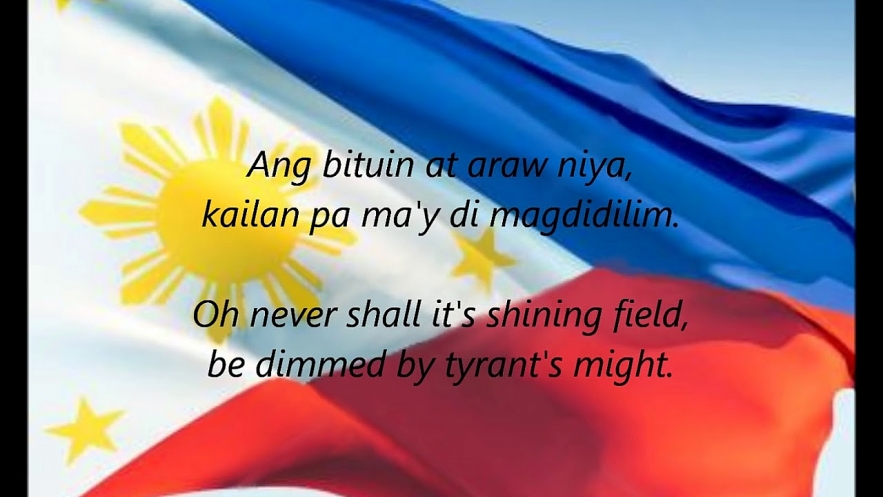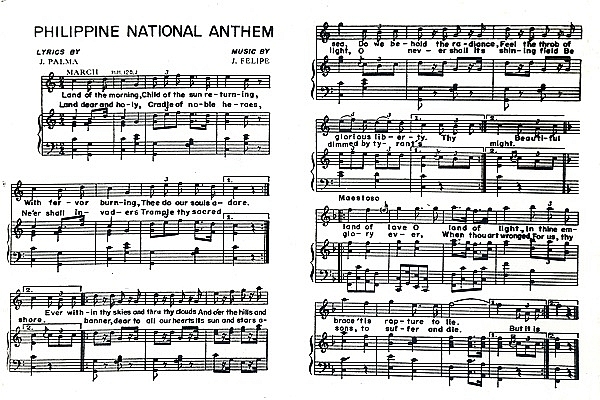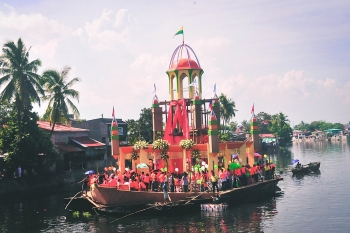What is the Philippine National Anthem: Lyrics of Spainish, Tagalog, English Version and History
 |
| Lupang Hinirang Lyrics - Philippine National Anthem |
Facts About The Philippine National Anthem
Meaning
The Philippine National Anthem is usually sang in schools as well as city and municipality halls during the flag ceremony.
Lupang Hinirang has been sung as the Philippine National Anthem since 1956 when Ramon Magsaysay was president of the country. It was translated into Tagalog from the original Spanish by Julian Cruz Balmaceda, Ildefonso Santos and Francisco Caballo.
How to sing
When singing the national anthem, the right hand is placed on the left chest with the body straight and other hand freely pointing downward. Filipinos must also face the flag when singing the anthem.
History - Philippine National Anthem
The Philippine National Anthem is a product of revolution, a response to the need of the revolutionary times that gave birth to it. And this need arose in 1898, when the revolution against Spain was in its second year and a Filipino victory was in sight.
Gen. Emilio Aguinaldo astutely recognized the need for national symbols to rally the nation against the enemy. On June 5, 1898, he commissioned Julian Felipe , a Cavite pianist and composer, to work on a march for the revolutionists. Felipe worked on the assignment for six days and on June 11, sitting in front of a piano in the Aguinaldo living room, played his music before the presidente and his lieutenants. Named by Felipe the Marcha Filipino Magdalo (after Aguinaldo's nom de guerre and his faction in the Katipunan), the music was adopted on the spot and renamed the Marcha Nacional Filipina (Philippine National March).
The national anthem was heard publicly for the first time on June 12, 1898, when, standing on the balcony of his Kawit mansion, Aguinaldo proclaimed Asia's first independent republic before a cheering throng. Two rallying symbols were presented to the infant nation that day. Also displayed for the first time was the national flag, unfurled to the stirring strains of the marcha nacional played by the band of San Francisco de Malabon (now Heneral Trias) whose members had learned the music the day before.
But still without words, Felipe's music was simply a march. It could not be sung. The need for lyrics was just as great as there was for the music. In December 1898, the Philippines was ceded by Spain to the United States of America in the Treaty of Paris. Having thrown off Spanish rule, the Filipinos found themselves under new colonial masters, the Americans. In February of 1899, the Filipino-American War erupted.
The defiant lyrics to march the stirring strains of Felipe were supplied by Jose Palma, a 23-year old soldier who was as adept with the pen as he was with the sword. He wrote a poem entitled "Filipinas" and this was wed to the Felipe composition. The anthem was readily taken by the young nation at war. But on March 23,1901, the war with America ground to a halt with the capture of Aguinaldo in Palanan, Isabela.
The first half of the century were years of humiliation for the Filipinos and their anthem. The American administors discouraged the singing of the anthem and in the 1920s, Palma's original spanish lyrics underwent several English and Tagalog translations. The most popular were the following versions, one in English by Camilo Osias and M.A.L. Lane and one in Tagalog.
The official Filipino lyrics
Finally, during the term of President Ramon Magsaysay, two Filipinos by the name of Julian Cruz Balmaceda and Ildefonso Santos translated the lyrics into Filipino with the title "Lupang Hinirang", which became the official version of the Philippine National Anthem in 1956.
In 1956, a new version penned by the Surian ng Wikang Pambansa (Institute of National Language) was adopted. These are the official Filipino lyrics sung all over the country today and given wider propagation through radio, television and cinema.
| The Philippine National Anthem was composed by Julian Felipe as instructed by General Emilio Aguinaldo. It was first played publicly on June 12, 1898 by the town band of San Francisco de Malabon on the occasion of the proclamation of Philippine Independence and the unfurling of the Philippine Flag in Kawit, Cavite. For more than a year the Philippine National Anthem remained without any lyrics, until Jose Palma wrote the poem Filipinas in Spanish, which became the original words of the anthem. During the American colonial rule of the Philippines, the Spanish lyrics of the anthem was translated into English titled The Philippine Hymn by a Filipino writer, Camilo Osias, and an American, A.L. Lane. |
 |
| On September 23, 1943, the National Anthem and National Flag were declared official symbols by virtue of Presidential Decree No. 211. But the development of the Philippine national anthem into what it is today took several years. |
Full Lyrics of The Official Philippine National Anthem - Lupang Hinirang in Philipino Version (Tagalog Version)
Bayang Magiliw, Perlas ng Silanganan
Alab ng Puso sa dibdib mo'y buhay
Lupang Hinirang, Duyan ka ng magiting,
Sa manlulupig di ka pasisiil.
Sa dagat at bundok,
Sa simoy at sa langit mong bughaw,
May dilag ang tula
At awit sa paglayang minamahal.
Ang kislap ng watawat mo'y
Tagumpay na nagniningning;
Ang bituin at araw niya
Kailan pa ma'y di magdidilim.
Lupa ng araw, ng luwalhati't pagsinta,
Buhay ay langit sa piling mo;
Aming ligaya na pag may mang-aapi
Ang mamatay nang dahil sa iyo.
The English Version of the Philippine National Anthem
Land Beloved (1919) (Pre-Commonwealth English version)
O land beloved,
Child of the sunny Orient,
Whose ardent spirit
Ever burns in thy breast!
O land of beauty,
Cradle of valiant warriors,
Tyrant oppressors
Never will daunt thy sons!
On the blue seas and verdant hills
And in the winds and azure skies,
Thy immortal voice of Liberty
We hear in ringing song arise.
On thy dear banner that has led
Thy sons to victory in the fight,
Forever shall its sun and stars
Unclouded shine with golden light.
Philippines, O land beloved of the sun,
On thy dear bosom life is sweet!
But in the hour when men must die for thee,
Gladly our lives we’ll lay at thy feet!
The Philippine National Anthem
(Most Common English Version)
Land of the Morning,
Child of the sun returning,
With fervor burning,
Thee do our souls adore.
Land dear and holy,
Cradle of noble heroes,
Ne’er shall invaders
Trample thy sacred shore.
Ever within thy skies and through thy clouds
And o’er thy hills and sea
Do we behold the radiance, feel the throb,
Of glorious liberty.
Thy banner, dear to all our hearts,
Its sun and stars alight,
O, never shall its shining field
Be dimmed by tyrant’s might!
Beautiful land of love,
O land of light,
In thine embrace ‘tis rapture to lie,
But it is glory ever, when thou art wronged,
For us, thy sons, to suffer and die.
(Translated from the Spanish
by Camilo Osias and M.A.L. Lane.
From Camilo Osias,
Manlapaz Publishing Co., 1971)
Spirit of the Country (Unofficial English translation)
Land that is blessed,
that is Pearl of the East;
Nation in union
with [the whole of] nature.
The life and riches
Of the Filipino people
Taken and reclaimed
From foreign hands.
In Thy skies, mountains,
Springs, seas that were conquered
Buried already is the darkness
Of yesterday’s suffering.
Pain and tears, hardship,
Difficulty and curse of oppression
Are all gone and [we] are saved
From those who wish to be cruel [to us].
Come, let us celebrate, my beloved race,
Thy flag shall be our guiding light;
And should Thou be once more threatened,
Our corpses shall block the way.
O Beloved Land (Unofficial English translation)
O beloved land,
Pearl of the Orient,
A fiery spirit Thou art
From the sun come forth.
Land dearest,
Nest of valour,
Against conquerors
Ready to fight and destroy.
In Thy seas and mountains,
In Thy blue skies,
Shining and leaping to and fro
Is Freedom without end.
Thy flag, when there is war,
Of victory is desirous;
They shall never dim forevermore,
Its sun and stars!
In Thee, Land of joy and loving,
Is so sweet to live.
Therefore it is heaven for us, for Thy sake
When Thou art oppressed, to lay down our lives.
The Spanish Version of the Philippine National Anthem
Tierra adorada
Hija del sol de Oriente
Su fuego ardiente
En ti latiendo esta.
***
Patria de amores!
Del heroismo cuna,
Los invasores
No te hallaran jamas.
****
En tu azul cielo, en tus auras,
En tus montes y en tu mar
Esplende y late el poema
De tu amada libertad.
****
Tu pabellon, que en las lides
La victoria ilumino
No vera nunca apagados
Sus estrellas y su sol.
****
Tierra de dichas, del sol y amores,
En tu regazo dulce es vivir.
Es una gloria para tus hijos,
Cuando de ofenden, por ti morir.
 Top 12 Most Popular Traditions of New Year's Eve in Philippines Top 12 Most Popular Traditions of New Year's Eve in Philippines New Year’s Eve is a time for celebrating all over the world, but few places have as many traditions and superstitions surrounding this holiday ... |
The Philippines has several national symbols. The national symbols of the Philippines consist of symbols that represent Philippine traditions and ideals and convey the principles ... |
 TOP 15 Most Popular Holidays in Philippines TOP 15 Most Popular Holidays in Philippines 2021 is coming with lots of vacations as well as holidays - festivals in every corner of the Philippines. Knowinsider ranked the 15 biggest ... |























